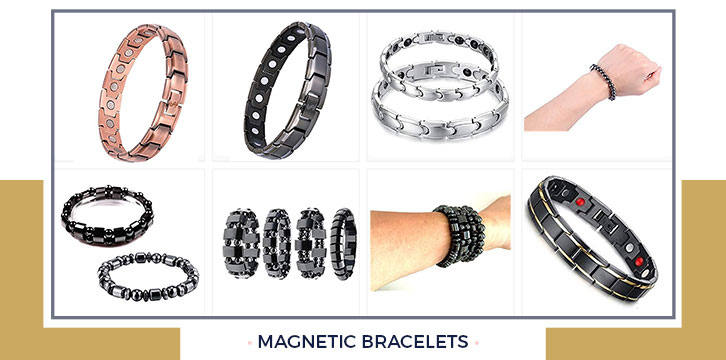There has been much controversy in recent years about the use of magnetic bracelets for the use of pain management. The magnetic therapy industry is a three billion dollar a year business, so the sellers of this type of jewelry and other various types of devices definitely have a vested interest in promoting them as “pain relieving” and generally good for a person’s health. Here are some basic things you should know before you make the decision to buy.

Please note: This article is not to take the place of seeing a doctor for pain or other illness. If you have pain that you do not know the cause of, please see your doctor before trying to use magnetic therapy.
What is Magnetic Therapy?
Magnetic therapy uses metal magnets that are worn in various places on the body. Magnetic bracelets and necklaces are the most common ways to implement magnetic therapy. Adhesive patches, bands, belts, blankets, and insoles are some of the other ways that magnetic therapy practitioners can implement therapy for their patients. These magnetic devices can be worn for differing lengths of time, sometimes for only a few minutes, sometimes for days or weeks at a time.
History of Magnetic Bracelets Therapy
Magnetic therapy has a long history. Paracelsus, a physician from the 16th century, thought that because blood contained iron, a magnet would attract diseases in the blood and possibly eliminate them. Magnets were used throughout the Middle Ages to treat various medical conditions such as arthritis and poisoning. In recent history, more scientific studies have been conducted on the effects of magnets on the human body with mixed results. One researcher in the 1970’s claimed that magnets could kill cancer cells and could cure glaucoma and infertility, as well as arthritis. Most of the studies done in recent years have not proven any benefits from magnetic therapy. One study was done at Baylor University that said that permanent magnets placed inside patients who had recovered from polio were helpful in the reduction of pain for the test patients was criticized and discounted by the medical community because the patients could tell whether they had been given a magnetized therapy device or not, so the “placebo effect” could not be fully determined for the study.
Possible Complications
Many people in recent years have claimed that magnets have helped reduce pain for them. This anecdotal evidence has helped the magnetic therapy business to thrive. Because there has been no conclusive proof of their effectiveness for medical treatments, the FDA and the FTC have both had to take action against some manufacturers and some sellers of magnetic bracelets and other magnetic therapy devices because they were claiming various health benefits could be had from those magnetic products. While health benefits from magnetic therapy have ever been proven, there are no known adverse effects from using magnetic therapy, either. However, anyone who has an implanted medical device such as a pacemaker, defibrillator, or infusion pump should NOT use magnetic therapy because those medical devices may be adversely affected by magnets.
To Buy or Not to Buy?
My advice to anyone thinking about buying a magnetic bracelet (or any magnetic therapy device) would be to do so with the knowledge that there is no proven evidence that you will get relief from your pain. That said, so many people do claim that they get pain relief, it is hard to ignore their claims. Unless there is a medical reason for not wearing a magnetic bracelet (as mentioned in the above paragraph), or your doctor recommends against it, I would say there is no reason not to try it. A magnetic bracelet is usually very inexpensive, and most of them are actually quite attractive. You can find stainless steel, leather and copper bracelet jewelry available, as well as many other types of magnetic jewelry like magnetic hematite bracelets and necklaces, and magnetic cubic zirconia rings. If you do feel that you receive pain relief, then that is a great bonus for you, in addition to having a nice piece of jewelry to wear.
